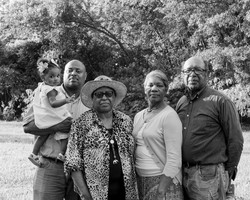The great land robbery
by Vann R. Newkirk II
I. Wiped Out

“You ever chop before?” Willena Scott-White was testing me. I sat with her in the cab of a Chevy Silverado pickup truck, swatting at the squadrons of giant, fluttering mosquitoes that had invaded the interior the last time she opened a window. I was spending the day with her family as they worked their fields just outside Ruleville, in Mississippi’s Leflore County. With her weathered brown hands, Scott-White gave me a pork sandwich wrapped in a grease-stained paper towel. I slapped my leg. Mosquitoes can bite through denim, it turns out.
Cotton sowed with planters must be chopped—thinned and weeded manually with hoes—to produce orderly rows of fluffy bolls. The work is backbreaking, and the people who do it maintain that no other job on Earth is quite as demanding. I had labored long hours over other crops, but had to admit to Scott-White, a 60-something grandmother who’d grown up chopping, that I’d never done it.
“Then you ain’t never worked,” she replied.
The fields alongside us as we drove were monotonous. With row crops, monotony is good. But as we toured 1,000 acres of land in Leflore and Bolivar Counties, straddling Route 61, Scott-White pointed out the demarcations between plots. A trio of steel silos here. A post there. A patch of scruffy wilderness in the distance. Each landmark was a reminder of the Scott legacy that she had fought to keep—or to regain—and she noted this with pride. Each one was also a reminder of an inheritance that had once been stolen.
Drive Route 61 through the Mississippi Delta and you’ll find much of the scenery exactly as it was 50 or 75 years ago. Imposing plantations and ramshackle shotgun houses still populate the countryside from Memphis to Vicksburg. Fields stretch to the horizon. The hands that dig into black Delta dirt belong to people like Willena Scott-White, African Americans who bear faces and names passed down from men and women who were owned here, who were kept here, and who chose to stay here, tending the same fields their forebears tended.
But some things have changed. Back in the day, snow-white bolls of King Cotton reigned. Now much of the land is green with soybeans. The farms and plantations are much larger—industrial operations with bioengineered plants, laser-guided tractors, and crop-dusting drones. Fewer and fewer farms are still owned by actual farmers. Investors in boardrooms throughout the country have bought hundreds of thousands of acres of premium Delta land. If you’re one of the millions of people who have a retirement account with the Teachers Insurance and Annuity Association, for instance, you might even own a little bit yourself.
TIAA is one of the largest pension firms in the United States. Together with its subsidiaries and associated funds, it has a portfolio of more than 80,000 acres in Mississippi alone, most of them in the Delta. If the fertile crescent of Arkansas is included, TIAA holds more than 130,000 acres in a strip of counties along the Mississippi River. And TIAA is not the only big corporate landlord in the region. Hancock Agricultural Investment Group manages more than 65,000 acres in what it calls the “Delta states.” The real-estate trust Farmland Partners has 30,000 acres in and around the Delta. AgriVest, a subsidiary of the Swiss bank UBS, owned 22,000 acres as of 2011. (AgriVest did not respond to a request for more recent information.)
Unlike their counterparts even two or three generations ago, black people living and working in the Delta today have been almost completely uprooted from the soil—as property owners, if not as laborers. In Washington County, Mississippi, where last February TIAA reportedly bought 50,000 acres for more than $200 million, black people make up 72 percent of the population but own only 11 percent of the farmland, in part or in full. In Tunica County, where TIAA has acquired plantations from some of the oldest farm-owning white families in the state, black people make up 77 percent of the population but own only 6 percent of the farmland. In Holmes County, the third-blackest county in the nation, black people make up about 80 percent of the population but own only 19 percent of the farmland. TIAA owns plantations there, too. In just a few years, a single company has accumulated a portfolio in the Delta almost equal to the remaining holdings of the African Americans who have lived on and shaped this land for centuries.
This is not a story about TIAA—at least not primarily. The company’s newfound dominance in the region is merely the topsoil covering a history of loss and legally sanctioned theft in which TIAA played no part. But TIAA’s position is instrumental in understanding both how the crimes of Jim Crow have been laundered by time and how the legacy of ill-gotten gains has become a structural part of American life. The land was wrested first from Native Americans, by force. It was then cleared, watered, and made productive for intensive agriculture by the labor of enslaved Africans, who after Emancipation would come to own a portion of it. Later, through a variety of means—sometimes legal, often coercive, in many cases legal and coercive, occasionally violent—farmland owned by black people came into the hands of white people. It was aggregated into larger holdings, then aggregated again, eventually attracting the interest of Wall Street.
Owners of small farms everywhere, black and white alike, have long been buffeted by larger economic forces. But what happened to black landowners in the South, and particularly in the Delta, is distinct, and was propelled not only by economic change but also by white racism and local white power. A war waged by deed of title has dispossessed 98 percent of black agricultural landowners in America. They have lost 12 million acres over the past century. But even that statement falsely consigns the losses to long-ago history. In fact, the losses mostly occurred within living memory, from the 1950s onward. Today, except for a handful of farmers like the Scotts who have been able to keep or get back some land, black people in this most productive corner of the Deep South own almost nothing of the bounty under their feet.
II. “Land Hunger”
Land has always been the main battleground of racial conflict in Mississippi. During Reconstruction, fierce resistance from the planters who had dominated antebellum society effectively killed any promise of land or protection from the Freedmen’s Bureau, forcing masses of black laborers back into de facto bondage. But the sheer size of the black population—black people were a majority in Mississippi until the 1930s—meant that thousands were able to secure tenuous footholds as landowners between Emancipation and the Great Depression.
Driven by what W. E. B. Du Bois called “land hunger” among freedmen during Reconstruction, two generations of black workers squirreled away money and went after every available and affordable plot they could, no matter how marginal or hopeless. Some found sympathetic white landowners who would sell to them. Some squatted on unused land or acquired the few homesteads available to black people. Some followed visionary leaders to all-black utopian agrarian experiments, such as Mound Bayou, in Bolivar County.
It was never much, and it was never close to just, but by the early 20th century, black people had something to hold on to. In 1900, according to the historian James C. Cobb, black landowners in Tunica County outnumbered white ones three to one. According to the U.S. Department of Agriculture, there were 25,000 black farm operators in 1910, an increase of almost 20 percent from 1900. Black farmland in Mississippi totaled 2.2 million acres in 1910—some 14 percent of all black-owned agricultural land in the country, and the most of any state.
The foothold was never secure. From the beginning, even the most enterprising black landowners found themselves fighting a war of attrition, often fraught with legal obstacles that made passing title to future generations difficult. Bohlen Lucas, one of the few black Democratic politicians in the Delta during Reconstruction (most black politicians at the time were Republicans), was born enslaved and managed to buy a 200-acre farm from his former overseer. But, like many farmers, who often have to borrow against expected harvests to pay for equipment, supplies, and the rent or mortgage on their land, Lucas depended on credit extended by powerful lenders. In his case, credit depended specifically on white patronage, given in exchange for his help voting out the Reconstruction government—after which his patrons abandoned him. He was left with 20 acres.
In Humphreys County, Lewis Spearman avoided the pitfalls of white patronage by buying less valuable wooded tracts and grazing cattle there as he moved into cotton. But when cotton crashed in the 1880s, Spearman, over his head in debt, crashed with it.
Around the turn of the century, in Leflore County, a black farm organizer and proponent of self-sufficiency—referred to as a “notoriously bad Negro” in the local newspapers—led a black populist awakening, marching defiantly and by some accounts bringing boycotts against white merchants. White farmers responded with a posse that may have killed as many as 100 black farmers and sharecroppers along with women and children. The fate of the “bad Negro” in question, named Oliver Cromwell, is uncertain. Some sources say he escaped to Jackson, and into anonymity.

Like so many of his forebears, Ed Scott Sr., Willena Scott-White’s grandfather, acquired his land through not much more than force of will. As recorded in the thick binders of family history that Willena had brought along in the truck, and that we flipped through between stretches of work in the fields, his life had attained the gloss of folklore. He was born in 1886 in western Alabama, a generation removed from bondage. Spurred by that same land hunger, Scott took his young family to the Delta, seeking opportunities to farm his own property. He sharecropped and rented, and managed large farms for white planters, who valued his ability to run their sprawling estates. One of these men was Palmer H. Brooks, who owned a 7,000-acre plantation in Mississippi’s Leflore and Sunflower Counties. Brooks was uncommonly progressive, encouraging entrepreneurship among the black laborers on his plantation, building schools and churches for them, and providing loans. Scott was ready when Brooks decided to sell plots to black laborers, and he bought his first 100 acres.
Unlike Bohlen Lucas, Scott largely avoided politics. Unlike Lewis Spearman, he paid his debts and kept some close white allies—a necessity, since he usually rejected government assistance. And unlike Oliver Cromwell, he led his community under the rules already in place, appearing content with what he’d earned for his family in an environment of total segregation. He leveraged technical skills and a talent for management to impress sympathetic white people and disarm hostile ones. “Granddaddy always had nice vehicles,” Scott-White told me. They were a trapping of pride in a life of toil. As was true in most rural areas at the time, a new truck was not just a flashy sign of prosperity but also a sort of credit score. Wearing starched dress shirts served the same purpose, elevating Scott in certain respects—always within limits—even above some white farmers who drove into town in dirty overalls. The trucks got shinier as his holdings grew. By the time Scott died, in 1957, he had amassed more than 1,000 acres of farmland.
Scott-White guided me right up to the Quiver River, where the legend of her family began. It was a choked, green-brown gurgle of a thing, the kind of lazy waterway that one imagines to be brimming with fat, yawning catfish and snakes. “Mr. Brooks sold all of the land on the east side of this river to black folks,” Scott-White told me. She swept her arm to encompass the endless acres. “All of these were once owned by black families.”
III. The Great Dispossession
That era of black ownership, in the Delta and throughout the country, was already fading by the time Scott died. As the historian Pete Daniel recounts, half a million black-owned farms across the country failed in the 25 years after 1950. Joe Brooks, the former president of the Emergency Land Fund, a group founded in 1972 to fight the problem of dispossession, has estimated that something on the order of 6 million acres was lost by black farmers from 1950 to 1969. That’s an average of 820 acres a day—an area the size of New York’s Central Park erased with each sunset. Black-owned cotton farms in the South almost completely disappeared, diminishing from 87,000 to just over 3,000 in the 1960s alone. According to the Census of Agriculture, the racial disparity in farm acreage increased in Mississippi from 1950 to 1964, when black farmers lost almost 800,000 acres of land. An analysis for The Atlantic by a research team that included Dania Francis, at the University of Massachusetts, and Darrick Hamilton, at Ohio State, translates this land loss into a financial loss—including both property and income—of $3.7 billion to $6.6 billion in today’s dollars.
This was a silent and devastating catastrophe, one created and maintained by federal policy. President Franklin D. Roosevelt’s New Deal life raft for agriculture helped start the trend in 1937 with the establishment of the Farm Security Administration, an agency within the Department of Agriculture. Although the FSA ostensibly existed to help the country’s small farmers, as happened with much of the rest of the New Deal, white administrators often ignored or targeted poor black people—denying them loans and giving sharecropping work to white people. After Roosevelt’s death, in 1945, conservatives in Congress replaced the FSA with the Farmers Home Administration, or FmHA. The FmHA quickly transformed the FSA’s programs for small farmers, establishing the sinews of the loan-and-subsidy structure that undergirds American agriculture today. In 1961, President John F. Kennedy’s administration created the Agricultural Stabilization and Conservation Service, or ASCS, a complementary program to the FmHA that also provided loans to farmers. The ASCS was a federal effort—also within the Department of Agriculture—but, crucially, the members of committees doling out money and credit were elected locally, during a time when black people were prohibited from voting.
Through these programs, and through massive crop and surplus purchasing, the USDA became the safety net, price-setter, chief investor, and sole regulator for most of the farm economy in places like the Delta. The department could offer better loan terms to risky farmers than banks and other lenders, and mostly outcompeted private credit. In his book Dispossession, Daniel calls the setup “agrigovernment.” Land-grant universities pumped out both farm operators and the USDA agents who connected those operators to federal money. Large plantations ballooned into even larger industrial crop factories as small farms collapsed. The mega-farms held sway over agricultural policy, resulting in more money, at better interest rates, for the plantations themselves. At every level of agrigovernment, the leaders were white.
Major audits and investigations of the USDA have found that illegal pressures levied through its loan programs created massive transfers of wealth from black to white farmers, especially in the period just after the 1950s. In 1965, the United States Commission on Civil Rights uncovered blatant and dramatic racial differences in the level of federal investment in farmers. The commission found that in a sample of counties across the South, the FmHA provided much larger loans for small and medium-size white-owned farms, relative to net worth, than it did for similarly sized black-owned farms—evidence that racial discrimination “has served to accelerate the displacement and impoverishment of the Negro farmer.”
In Sunflower County, a man named Ted Keenan told investigators that in 1956, local banks had denied him loans after a bad crop because of his position with the NAACP, where he openly advocated for voting rights. The FmHA had denied him loans as well. Keenan described how Eugene Fisackerly, the leader of the White Citizens’ Council in Sunflower County, together with representatives of Senator James Eastland, a notorious white supremacist who maintained a large plantation there, had intimidated him into renouncing his affiliation with the NAACP and agreeing not to vote. Only then did Eastland’s man call the local FmHA agent, prompting him to reconsider Keenan’s loan.
A landmark 2001 investigation by the Associated Press into extortion, exploitation, and theft directed against black farmers uncovered more than 100 cases like Keenan’s. In the 1950s and ’60s, Norman Weathersby, a Holmes County Chevrolet dealer who enjoyed a local monopoly on trucks and heavy farm equipment, required black farmers to put up land as collateral for loans on equipment. A close friend of his, William Strider, was the local FmHA agent. Black farmers in the area claimed that the two ran a racket: Strider would slow-walk them on FmHA loans, which meant they would then default on Weathersby’s loans and lose their land to him. Strider and Weathersby were reportedly free to run this racket because black farmers were shut out by local banks.
Analyzing the history of federal programs, the Emergency Land Fund emphasizes a key distinction. While most of the black land loss appears on its face to have been through legal mechanisms—“the tax sale; the partition sale; and the foreclosure”—it mainly stemmed from illegal pressures, including discrimination in federal and state programs, swindles by lawyers and speculators, unlawful denials of private loans, and even outright acts of violence or intimidation. Discriminatory loan servicing and loan denial by white-controlled FmHA and ASCS committees forced black farmers into foreclosure, after which their property could be purchased by wealthy landowners, almost all of whom were white. Discrimination by private lenders had the same result. Many black farmers who escaped foreclosure were defrauded by white tax assessors who set assessments too high, leading to unaffordable tax obligations. The inevitable result: tax sales, where, again, the land was purchased by wealthy white people. Black people’s lack of access to legal services complicated inheritances and put family claims to title in jeopardy. Lynchings, police brutality, and other forms of intimidation were sometimes used to dispossess black farmers, and even when land wasn’t a motivation for such actions, much of the violence left land without an owner.
In interviews with researchers from the Smithsonian’s National Museum of American History in 1985, Henry Woodard Sr., an African American who had bought land in the 1950s in Tunica County, said he had managed to keep up for years through a combination of his own industry, small loans from the FmHA and white banks, and the rental of additional land from other hard-pressed black landowners. Then, in 1966, the activist James Meredith—whose 1962 fight to integrate Ole Miss sparked deadly riots and a wave of white backlash—embarked on the famous March Against Fear. The next planting season, Woodard recalled, his white lenders ignored him. “I sensed that it was because of this march,” he said. “And it was a lady told me—I was at the post office and she told me, she said, ‘Henry, you Negroes, y’all want to live like white folks. Y’all don’t know how white folks live. But y’all are gonna have to be on your own now.’ ”
Woodard’s story would have been familiar to countless farmers in the Delta. In Holmes County, a crucible of the voting-rights movement, a black effort to integrate the local ASCS committees was so successful that it was subject to surveillance and sabotage by the Mississippi State Sovereignty Commission, an official agency created by Governor J. P. Coleman in 1956 to resist integration. Black landowners involved in running for the committees or organizing for votes faced fierce retaliation. In 1965, The New Republic reported that in Issaquena County, just north of Vicksburg, the “insurance of Negroes active in the ASCS elections had been canceled, loans were denied to Negroes on all crops but cotton, and ballots were not mailed to Negro wives who were co-owners of land.” Even in the decades after the passage of the 1965 Voting Rights Act, formal and informal complaints against the USDA poured out of the Delta.
These cases of dispossession can only be called theft. While the civil-rights era is remembered as a time of victories against disenfranchisement and segregation, many realities never changed. The engine of white wealth built on kleptocracy—which powered both Jim Crow and its slave-state precursor—continued to run. The black population in Mississippi declined by almost one-fifth from 1950 to 1970, as the white population increased by the exact same percentage. Farmers slipped away one by one into the night, appearing later as laborers in Chicago and Detroit. By the time black people truly gained the ballot in Mississippi, they were a clear minority, held in thrall to a white conservative supermajority.
Mass dispossession did not require a central organizing force or a grand conspiracy. Thousands of individual decisions by white people, enabled or motivated by greed, racism, existing laws, and market forces, all pushed in a single direction. But some white people undeniably would have organized it this way if they could have. The civil-rights leader Bayard Rustin reported in 1956 that documents taken from the office of Robert Patterson, one of the founding fathers of the White Citizens’ Councils, proposed a “master plan” to force hundreds of thousands of black people from Mississippi in order to reduce their potential voting power. Patterson envisioned, in Rustin’s words, “the decline of the small independent farmer” and ample doses of “economic pressure.”
An upheaval of this scale and speed—the destruction of black farming, an occupation that had defined the African American experience—might in any other context be described as a revolution, or seen as a historical fulcrum. But it came and went with little remark.
IV. The Catfish Boom
World War II transformed America in many ways. It certainly transformed a generation of southern black men. That generation included Medgar Evers, a future civil-rights martyr, assassinated while leading the Mississippi NAACP; he served in a segregated transportation company in Europe during the war. It included Willena’s father, Ed Scott Jr., who also served in a segregated transportation company. These men were less patient, more defiant, and in many ways more reckless than their fathers and grandfathers had been. They chafed under a system that forced them to relearn how to bow and scrape, as if the war had never happened. In the younger Scott’s case, wartime service sharpened his inherited land hunger, pushing him to seek more land and greater financial independence, both for himself and for his community. One of his siblings told his biographer, Julian Rankin, that the family’s deepest conviction was that “a million years from now … this land will still be Scotts’ land.”
Upon his return to the Delta, Scott continued down his father’s hard path, avoiding any interface with the FmHA and the public portions of the agrigovernment system, which by that time had spread its tendrils throughout Sunflower and Leflore Counties. He leaned on the friendships he and his father had made with local business owners and farmers, and secured credit for growing his holdings from friendly white bankers. Influenced by the civil-rights movement and its emphasis on community solidarity and activism, Scott borrowed from Oliver Cromwell’s self-sufficiency playbook too. He used his status to provide opportunities for other black farmers and laborers. “Daddy said that everyone who worked for us would always be able to eat,” Willena Scott-White told me. He made sure of more than that. Scott sent relatives’ and tenants’ children to school, paid for books, helped people open bank accounts and buy their own land. When civil-rights activists made their way down for Mississippi’s Freedom Summer, in 1964, he packed up meals and brought them to rallies.
When Scott-White thinks of her father, who died in 2015, she seems to become a young girl again. With allowances for nostalgia, she recalls a certain kind of country poorness-but-not-poverty, whereby children ran barefoot and worked from the moment they could walk, but ate well, lived in houses with solid floors and tight roofs, and went to high school and college if they showed skill. “We lived in something like a utopia,” Scott-White told me. But things changed at the tail end of the 1970s. Plummeting commodity prices forced highly leveraged farmers to seek loans wherever they could find them. Combined with the accelerating inflation of that decade, the beginnings of the farm-credit crisis made farming at scale without federal assistance impossible. Yet federal help—even then, two decades after the Civil Rights Act—was not available for most black farmers. According to a 2005 article in The Nation, “In 1984 and 1985, at the height of the farm crisis, the USDA lent a total of $1.3 billion to nearly 16,000 farmers to help them maintain their land. Only 209 of those farmers were black.”
As Rankin tells it in his biography, Catfish Dream, Scott made his first visit to an FmHA office in 1978. With the assistance of Vance Nimrod, a white man who worked with the black-owned Delta Foundation, a nonprofit promoting economic advancement for black Mississippians, Scott secured an operating loan for a season of soybeans and rice from the FmHA agent Delbert Edwards. The first time was easy—although, crucially, Nimrod accompanied him to the Leflore County office, in Greenwood. When Scott returned the next year without Nimrod, driving a shiny new truck the way his father used to, Edwards asked where Nimrod was. According to Rankin, Scott told the agent that Nimrod had only come to help secure that first loan; he wasn’t a business partner. When Edwards saw Scott’s vehicle, he seemed perplexed. “Who told you to buy a new truck?” he asked. Edwards ended up denying the requested loan amount.
At the same time, Edwards and the FmHA were moving to help local white farmers weather the storm, often by advising them to get into raising catfish. Commercial catfish farming was a relatively new industry, and it had found a home in the Delta as prices for row crops crashed and new legislation gave the USDA power and incentive to build up domestic fish farming. FmHA agents pushed white farmers to convert wide fields on the floodplain into giant catfish ponds, many of which would become contract-growing hubs for Delta Pride Catfish, a cooperative that quickly evolved into a local monopoly. The federal government poured millions of dollars into the catfish boom by way of FmHA loans, many of which were seized on by the largest white landowners, and kept those white landowners solvent. Mississippi became the catfish capital of the world in the 1970s. But the FmHA did not reach out to Scott, nor is there evidence that it supported the ambitions of any black farmers who might have wanted to get into catfish.
Scott decided to get into catfish anyway, digging eight ponds in fields where rice had grown the season before. He found his own catfish stocks and learned the ins and outs of the industry pretty much on his own. Scott finished digging his ponds in 1981, at which point, according to Rankin, Edwards of the FmHA visited the property and told him point-blank: “Don’t think I’m giving you any damn money for that dirt you’re moving.” The Mississippi FmHA would eventually compel Edwards to provide loans for Scott’s catfish operation for 1981 and 1982. But as court records show, the amount approved was far less than what white catfish farmers usually got—white farmers sometimes received double or triple the amount per acre that Scott did—and enough to stock only four of the eight ponds. (Edwards could not be reached for comment on any of the episodes recounted here.)
Scott’s Fresh Catfish opened in 1983. As a marker outside the old processing shed now indicates, it was the first catfish plant in the country owned by an African American. But discrimination doomed the enterprise before it really began. Without enough capital, Scott was never able to raise fish at the volume he needed. He claimed in court and later to Rankin that he had also been denied a chance to purchase stock in Delta Pride—a requirement to become a contract grower—because he was black. Without access to a cooperative, he had to do the processing and packaging himself, adding to the cost of his product. In 2006, Delta Pride and Country Select Catfish were combined into a new business entity, Consolidated Catfish Producers. When reached for comment, a spokesperson for Consolidated Catfish said that no employee at the new company could “definitively answer” questions about Scott or alleged discrimination against him.
Scott was in his 60s by the time his plant got off the ground. The effort took a toll. He slowly went blind. Arthritis claimed his joints. His heart began to fail. The plant limped quietly through the ’80s and then shut down. Lenders began the process of foreclosing on some of Scott’s cropland as early as 1983. In 1995, the FmHA approved a request from Scott to lease most of his remaining acres. The USDA itself had claimed most of his land by the late 1980s.
The downfall of the Scott catfish enterprise was proof of the strength and endurance of what the federal government would later state could be seen as a federally funded “conspiracy to force minority and disadvantaged farmers off their land through discriminatory loan practices.” The Scotts were not small-timers. They had the kind of work ethic and country savvy that are usually respected around the Delta. When the powers that be finally prevailed over Ed Scott Jr., they had completed something decisive, something that even today feels as if it cannot be undone.
V. Farmers in Suits
But land is never really lost, not in America. Twelve million acres of farmland in a country that has become a global breadbasket carries immense value, and the dispossessed land in the Delta is some of the most productive in America. The soil on the alluvial plain is rich. The region is warm and wet. Much of the land is perfect for industrialized agriculture.
Some white landowners, like Norman Weathersby, themselves the beneficiaries of government-funded dispossession, left land to their children. Some sold off to their peers, and others saw their land gobbled up by even larger white-owned farms. Nowadays, as fewer and fewer of the children of aging white landowners want to continue farming, more land has wound up in the hands of trusts and investors. Over the past 20 years, the real power brokers in the Delta are less likely to be good ol’ boys and more likely to be suited venture capitalists, hedge-fund managers, and agribusiness consultants who run farms with the cold precision of giant circuit boards.
One new addition to the mix is pension funds. Previously, farmland had never been a choice asset class for large-scale investing. In 1981, what was then called the General Accounting Office (now the Government Accountability Office) released a report exploring a proposal by a firm seeking pension-investment opportunities in farmland. The report essentially laughed off the prospect. The authors found that only about one dollar of every $4,429 in retirement funds was invested in farmland.
But commodity prices increased, and land values rose. In 2008, a weakened dollar forced major funds to broaden their search for hedges against inflation. “The market in agricultural land in the U.S. is currently experiencing a boom,” an industry analyst, Tom Vulcan, wrote that year. He took note of the recent entry of TIAA-CREF, which had “spent some $340 million on farmland across seven states.” TIAA, as the company is now called, would soon become the biggest pension-fund player in the agricultural real-estate game across the globe. In 2010, TIAA bought a controlling interest in Westchester Group, a major agricultural-asset manager. In 2014, it bought Nuveen, another large asset-management firm. In 2015, with Nuveen directing its overall investment strategy and Westchester and other smaller subsidiaries operating as purchasers and managers, TIAA raised $3 billion for a new global farmland-investment partnership. By the close of 2016, Nuveen’s management portfolio included nearly 2 million acres of farmland, worth close to $6 billion.
Investment in farmland has proved troublesome for TIAA in Mississippi and elsewhere. TIAA is a pension company originally set up for teachers and professors and people in the nonprofit world. It has cultivated a reputation for social responsibility: promoting environmental sustainability and respecting land rights, labor rights, and resource rights. TIAA has endorsed the United Nations–affiliated Principles for Responsible Investment, which include special provisions for investment in farmland, including specific guidelines with regard to sustainability, leasing practices, and establishing the provenance of tracts of land.
The company has faced pushback for its move into agriculture. In 2015, the international nonprofit Grain, which advocates for local control of farmland by small farmers, released the results of an investigation accusing TIAA’s farmland-investment arm of skirting laws limiting foreign land acquisition in its purchase of more than half a million acres in Brazil. The report found that TIAA had violated multiple UN guidelines in creating a joint venture with a Brazilian firm to invest in farmland without transparency. The Grain report alleges that when Brazil tightened laws designed to restrict foreign investment, TIAA purchased 49 percent of a Brazilian company that then acted as its proxy. According to The New York Times, TIAA and its subsidiaries also appear to have acquired land titles from Euclides de Carli, a businessman often described in Brazil as a big-time grileiro—a member of a class of landlords and land grabbers who use a mix of legitimate means, fraud, and violence to force small farmers off their land. In response to criticism of TIAA’s Brazil portfolio, Jose Minaya, then the head of private-markets asset management at TIAA, told WNYC’s The Takeaway: “We believe and know that we are in compliance with the law, and we are transparent about what we do in Brazil. From a title perspective, our standards are very focused around not displacing individuals or indigenous people, respecting land rights as well as human rights … In every property that we have acquired, we don’t just do due diligence on that property. We do due diligence on the sellers, whether it’s an individual or whether it’s an entity.”
TIAA’s land dealings have faced scrutiny in the United States as well. In 2012, the National Family Farm Coalition found that the entry into agriculture of deep-pocketed institutional investors—TIAA being an example—had made it pretty much impossible for smaller farmers to compete. Institutional investment has removed millions of acres from farmers’ hands, more or less permanently. “Pension funds not only have the power to outbid smaller, local farmers, they also have the long-term goal of retaining farmland for generations,” the report noted.
Asked about TIAA’s record, a spokesperson for Nuveen maintained that the company has built its Delta portfolio following ethical-investment guidelines: “We have a long history of investing responsibly in farmland, in keeping with our corporate values and the UN-backed Principles for Responsible Investment (PRI). As a long-term owner, we bring capital, professional expertise, and sustainable farming practices to each farm we own, and we are always looking to partner with expansion-minded tenants who will embrace that approach and act as good stewards of the land.” The company did not comment on the history of any individual tract in its Delta portfolio.
But even assuming that every acre under management by big corporate interests in the Delta has been acquired by way of ethical-investment principles, the nature of the mid-century dispossession and its multiple layers of legitimation raise the question of whether responsible investment in farmland there is even possible. As a people and a class, black farmers were plainly targets, but the deed histories of tax sales and foreclosures don’t reveal whether individual debtors were moved off the land because of discrimination and its legal tools.
In addition, land records are spotty in rural areas, especially records from the 1950s and ’60s, and in some cases it’s unclear exactly which records the investors used to meet internal requirements. According to Tristan Quinn-Thibodeau, a campaigner and organizer at ActionAid, an anti-poverty and food-justice nonprofit, “It’s been a struggle to get this information.” The organization has tried to follow the trails of deeds and has asked TIAA—which manages ActionAid’s own pension plan—for an analysis of the provenance of its Delta portfolio. Such an analysis has not been provided.
What we do know is that, whatever the specific lineage of each acre, Wall Street investors have found a lucrative new asset class whose origins lie in part in mass dispossession. We know that the vast majority of black farmland in the country is no longer in black hands, and that black farmers have suffered far more hardships than white farmers have. The historian Debra A. Reid points out that “between 1920 and 1997, the number of African Americans who farmed decreased by 98 percent, while white Americans who farmed declined by 66 percent.” Referring to the cases studied in their 2001 investigation, Dolores Barclay and Todd Lewan of the Associated Press observed that virtually all of the property lost by black farmers “is owned by whites or corporations.” The foundation of these portfolios was a system of plantations whose owners created the agrigovernment system and absorbed thousands of small black-owned farms into ever larger white-owned farms. America has its own grileiros, and they stand on land that was once someone else’s.
VI. A Deeper Excavation
As we drove through the patchwork remnants of the Scotts’ land, Willena Scott-White took me to the site of Scott’s Fresh Catfish. Gleaming steel silos had turned into rusting hulks. The ponds were thick with weeds and debris. The exterior walls of the plant itself had collapsed. Rusted beams lay atop ruined machinery. Fire ants and kudzu had begun nature’s reclamation.
Late in Ed Scott Jr.’s life, as he slipped into Alzheimer’s, Willena and his lawyer, Phil Fraas, fought to keep his original hopes alive. In the Pigford v. Glickman lawsuit of 1997, thousands of black farmers and their families won settlements against the USDA for discrimination that had occurred between 1981 and the end of 1996; the outlays ultimately reached a total of $2 billion. The Scotts were one of those families, and after a long battle to prove their case—with the assistance of Scott-White’s meticulous notes and family history—in 2012 the family was awarded more than $6 million in economic damages, plus almost $400,000 in other damages and debt forgiveness. The court also helped the Scotts reclaim land possessed by the department. In a 1999 ruling, Judge Paul L. Friedman of the U.S. District Court for the District of Columbia acknowledged that forcing the federal government to compensate black farmers would “not undo all that has been done” in centuries of government-sponsored racism. But for the Scotts, it was a start.
“The telling factor, looking at it from the long view, is that at the time of World War I there were 1 million black farmers, and in 1992 there were 18,000,” Fraas told me. The settlements stemming from Pigford cover only specific recent claims of discrimination, and none stretching back to the period of the civil-rights era, when the great bulk of black-owned farms disappeared. Most people have not pushed for any kind of deeper excavation.
Any such excavation would quickly make plain the consequences of what occurred. During my drive with Scott-White, we traveled through parts of Leflore, Sunflower, and Washington Counties, three of the counties singled out by Opportunity Insights, a Harvard University research group, as among the worst in the country in terms of a child’s prospects for upward mobility. Ten counties in the Delta are among the poorest 50 in America. According to new data from the Centers for Disease Control and Prevention on all 74,000 U.S. census tracts, four tracts in the Delta are among the lowest 100 when it comes to average life expectancy. More than 30 tracts in the Delta have an average life expectancy below 70. (The national average is 79.) In some Delta counties, the infant mortality rate is more than double the nationwide rate. As if to add gratuitous insult to injury, a new analysis from ProPublica finds that, as a result of the Internal Revenue Service’s intense scrutiny of low-income taxpayers, the Delta is audited by the IRS more heavily than any other place in the country. In sum, the areas of deepest poverty and under the darkest shadow of death are the ones where dispossession was the most far-reaching.
The consequences of dispossession had long been predicted. Fannie Lou Hamer, a Sunflower County activist whose 1964 speech to a Democratic National Convention committee galvanized support for the Voting Rights Act, spoke often of the need for land reform as a precondition for true freedom. Hamer’s utopian Freedom Farm experiment stressed cooperative landownership, and she said the concentration of land in the hands of a few landowners was “at the base of our struggle for survival.” In her analysis, mass dispossession should be seen as mass extraction. Even as the U.S. government invested billions in white farmers, it continued to extract wealth from black farmers in the Delta. Each black farmer who left the region, from Reconstruction onward, represented a tiny withdrawal from one side of a cosmic balance sheet and a deposit on the other side. This dynamic would only continue, in other ways and other places, as the Great Migration brought black families to northern cities.
This cosmic balance sheet underpins the national conversation—ever more robust—about reparations for black Americans. In that conversation, given momentum in part by the publication of Ta-Nehisi Coates’s “The Case for Reparations” in this magazine in 2014, I hear echoes of Mississippi. I hear echoes of Hamer, the Scotts, Henry Woodard Sr., and others who petitioned the federal government to hold itself accountable for a history of extraction that has extended well beyond enslavement. But that conversation too easily becomes technical. How do we quantify discrimination? How do we define who was discriminated against? How do we repay those people according to what has been defined and quantified? The idea of reparations sometimes seems like a problem of economic rightsizing—something for the quants and wonks to work out.
Economics is, of course, a major consideration. According to the researchers Francis and Hamilton, “The dispossession of black agricultural land resulted in the loss of hundreds of billions of dollars of black wealth. We must emphasize this estimate is conservative … Depending on multiplier effects, rates of returns, and other factors, it could reach into the trillions.” The large wealth gap between white and black families today exists in part because of this historic loss.
But money does not define every dimension of land theft. Were it not for dispossession, Mississippi today might well be a majority-black state, with a radically different political destiny. Imagine the difference in our national politics if the center of gravity of black electoral strength had remained in the South after the Voting Rights Act was passed.
Politics aside, how can reparations truly address the lives ruined, the family histories lost, the connection to the land severed? In America, land has always had a significance that exceeds its economic value. For a people who were once chattel themselves, real property has carried an almost mystical import. There’s a reason the fabled promise that spread among freedmen after the Civil War was not a check, a job, or a refundable tax credit, but 40 acres of farmland to call home. The history of the Delta suggests that any conversation about reparations might need to be more qualitative and intangible than it is. And it must consider the land.
Land hunger is ineffable, an indescribable yearning, and yet it is something that Americans, perhaps uniquely, feel and understand. That yearning tugged at me hardest as Willena Scott-White rounded out her tour of the fields, the afternoon slipping away. Out among the Scotts’ fields is a clearing with a lone, tall tree. In the clearing is a small cemetery. A handful of crooked, weathered tombstones stand sentinel. This is where Ed Scott Jr. is buried, and where some of Willena’s older siblings now rest. Willena posed for a picture beside her parents’ grave. She told me that this is where her own bones will rest after her work on Earth is done.
“This is our land,” she said.












